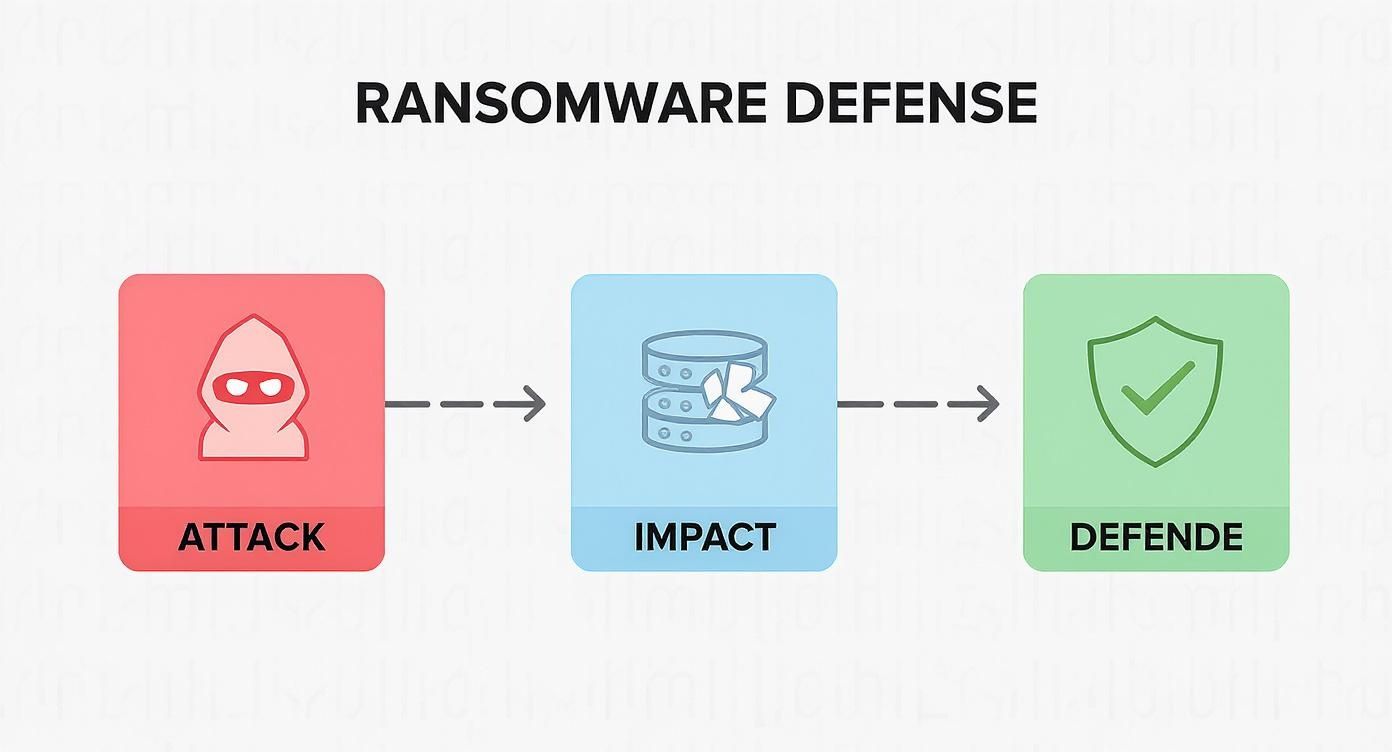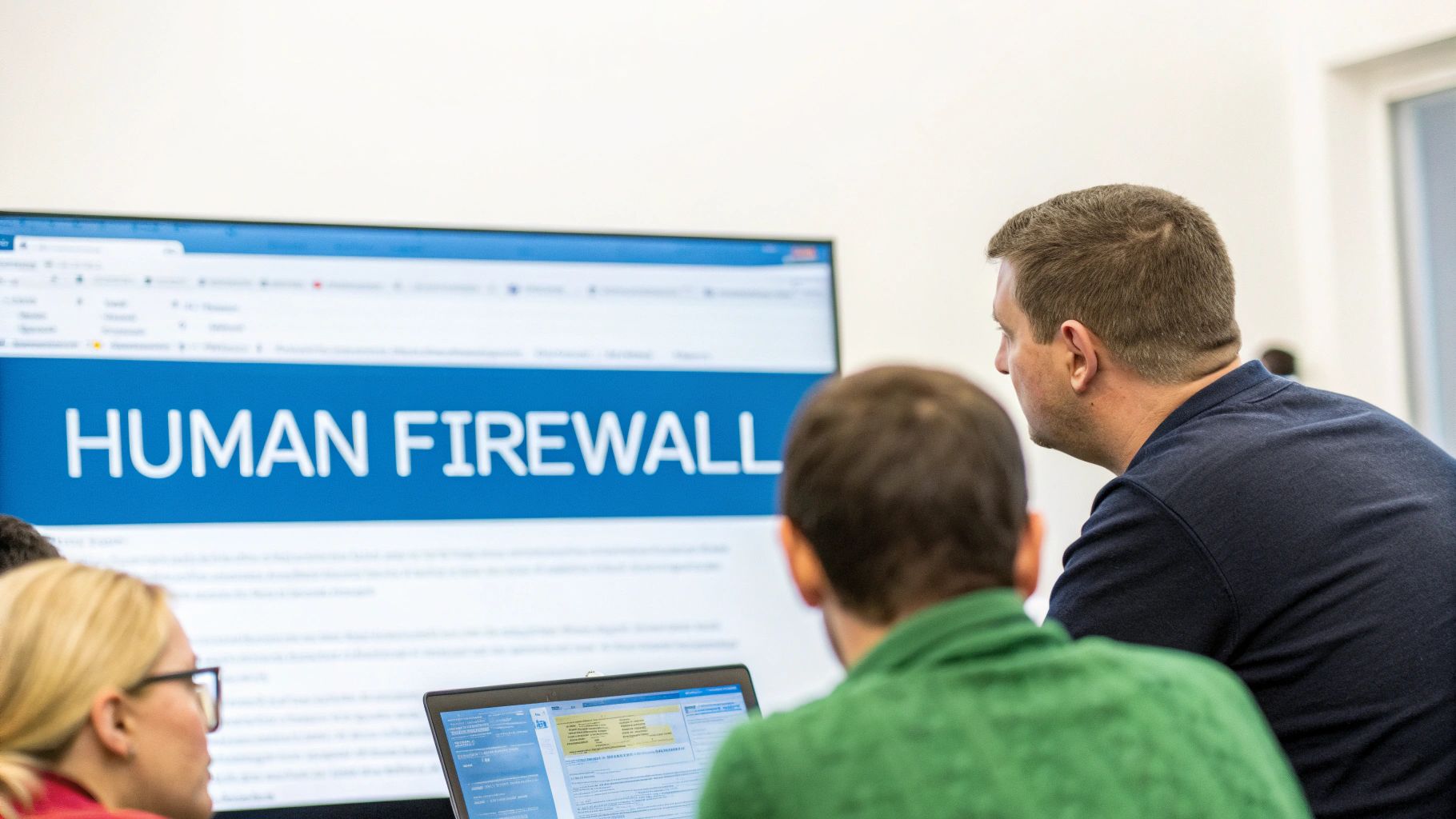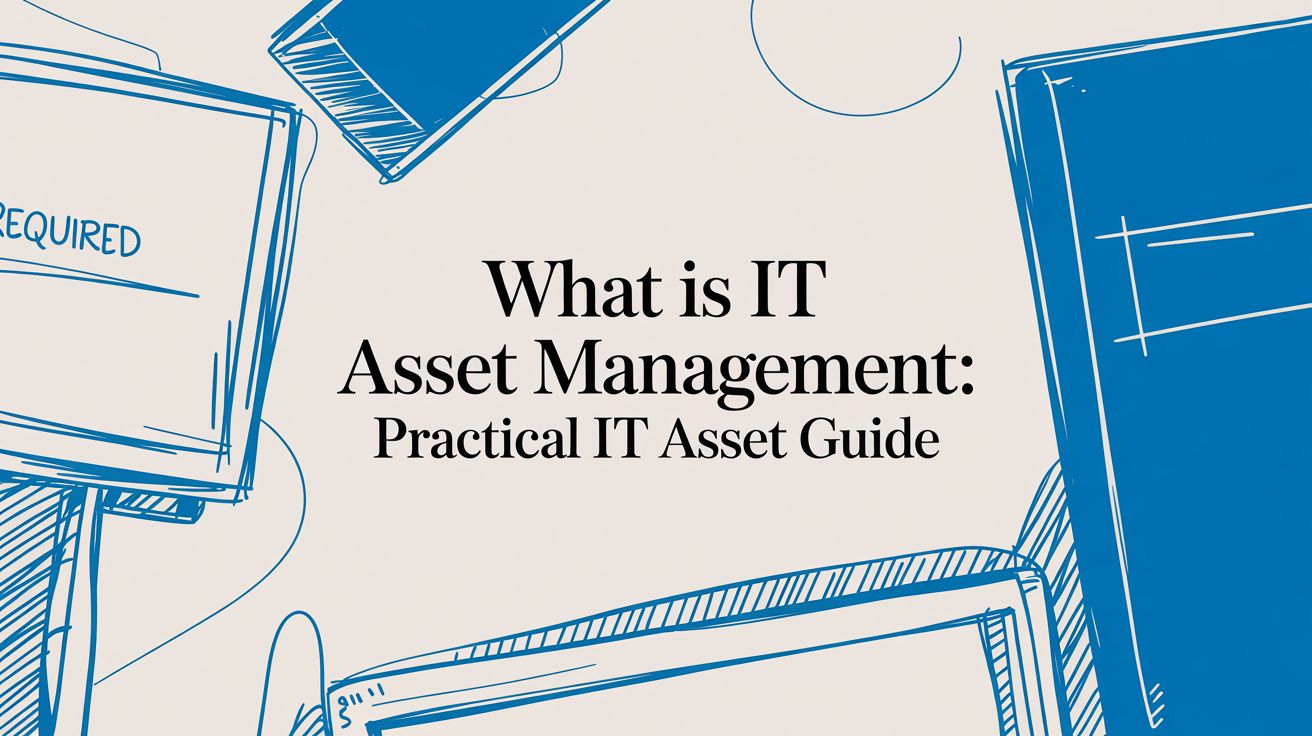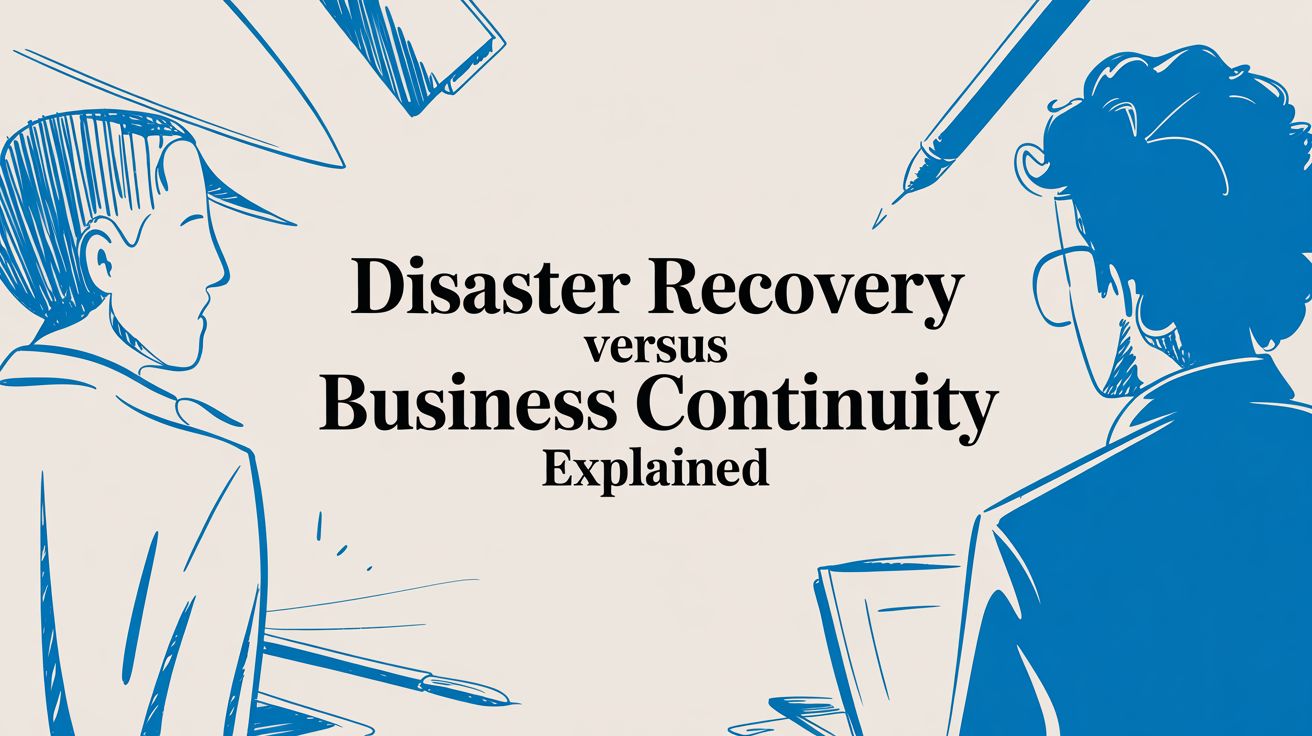How to Protect Against Ransomware: A Guide for SMBs
Protecting your business from ransomware isn't about finding a single magic bullet. It’s about building a proactive, layered defense managed by IT professionals. Think of it as a combination of robust data backups, smart employee training, and modern endpoint security. Together, these layers create a defense that’s far stronger than any single part. This guide will walk you through the essential pillars of that defense, framed for the real-world challenges faced by small and mid-sized businesses.
The Real Ransomware Threat to Your Business
Picture a typical Tuesday morning at your Dallas logistics company. Everything is running smoothly, shipments are on schedule, and then suddenly, a key server goes offline. What you initially think is a minor IT glitch is actually a ransomware attack. Your most critical files are encrypted, and your entire operation grinds to a halt.
This isn't a hypothetical scenario for a Fortune 500 company; it's a harsh reality for small and mid-sized businesses (SMBs) across Dallas and Memphis every day. The damage goes way beyond the ransom demand itself. The true cost is measured in days of crippling downtime, lost revenue, emergency data recovery fees, and the kind of shattered client trust that can take years to rebuild.
Understanding the Scale of the Threat
Don't make the mistake of thinking you're too small to be a target. Ransomware is a highly automated industry, and attackers usually hunt for vulnerabilities, not company size. If you have a weakness, they will find it.
The numbers don’t lie. In 2023, the U.S. was the target of 47% of all attacks worldwide. It's getting worse, with projections showing an attack could happen every two seconds by 2031. Cybercriminals are experts at exploiting the low-hanging fruit: convincing phishing emails, unpatched software, and insecure Remote Desktop Protocol (RDP) setups. This isn't a distant problem—it's right on your doorstep. For more on the latest trends, the data on Spacelift.io is eye-opening.
Beyond the Ransom Demand
The cost of a ransomware attack creates a domino effect of operational and financial chaos. The ransom payment is often just the tip of the iceberg.
Let's break down what you're really up against.
The True Cost of a Ransomware Attack
As you can see, the financial bleeding continues long after the initial attack is contained.
A proactive approach is the only reliable way to protect against ransomware. Waiting until an attack happens means you've already lost. The goal is to build a resilient defense that makes your business an unattractive and difficult target for cybercriminals.
A truly layered defense combines smart technology with human awareness. This means having a rock-solid backup strategy is non-negotiable, but it also means ensuring your team can spot a threat and that your network is buttoned up. For a deeper dive into securing your digital perimeter, check out our guide on network security best practices.
Your Ultimate Safety Net: Data Backups and Recovery
Let's be realistic: even the best defenses can be breached. A sophisticated ransomware attack can slip through the cracks, and when it does, your backup and recovery strategy is the only thing standing between a minor headache and a full-blown catastrophe.
This isn't just about having copies of your files. It's about having a tested, resilient system that makes the very idea of paying a ransom laughable.
This infographic lays out the typical playbook for a ransomware event, and more importantly, how a proactive defense can completely defang it.

As you can see, a strong recovery plan flips the script, turning a potentially business-ending attack into a manageable, albeit stressful, incident.
The 3-2-1 Rule In Action
For any small business, the gold standard for data resilience is the 3-2-1 backup rule. It’s a simple but powerful framework that ensures you’re never caught without a viable recovery option.
Here’s how it works:
- Keep three total copies of your data—the original data on your live systems, plus two backups.
- Use two different types of media for storage. Think a local network-attached storage (NAS) device combined with secure cloud storage.
- Store one of those copies completely offsite. This protects you from a localized disaster like a fire, flood, or even theft of your office equipment.
We saw this rule save a Memphis-based accounting firm. They had local backups on an office server and a second, encrypted copy stored in Microsoft Azure. When ransomware hit and encrypted their entire local network—including their primary backups—they didn't panic. Their offsite cloud backup was completely isolated and untouched. They restored everything without paying a dime.
Not All Backups Are Created Equal
It's tempting to think that backing up to a USB drive you keep plugged in is enough. It's not. Modern ransomware is smart; it actively hunts for and encrypts connected backup drives.
That's why a layered approach is non-negotiable. You need a mix of local backups for quick file restores and robust cloud services like Azure Backup for true disaster recovery. The cloud gives you that critical physical separation from your office network.
The real game-changer in ransomware defense is immutable storage. An immutable backup is a copy of your data that, once created, cannot be changed or deleted for a specific period. This creates a pristine, untouchable version of your files, giving you a guaranteed clean recovery point.
This concept of an "air-gapped" backup—one that's completely disconnected from your live network—is your ace in the hole.
Look Beyond Backups to Business Continuity
Having reliable backups is one thing; knowing exactly how to use them under pressure is another. This is where a Business Continuity and Disaster Recovery (BCDR) plan comes into play. A BCDR plan is your step-by-step roadmap for getting back to business after everything goes sideways.
It forces you to answer the tough questions before a crisis hits:
- Which systems and applications need to be restored first?
- Who has the authority to declare a disaster and kick off the recovery?
- How will your team communicate and work while core systems are down?
- What's a realistic timeline for getting critical functions back online?
Strong backups are incredibly effective. While 40.2% of ransomware attacks also involve data theft, a staggering 90% of incidents either fail completely or result in zero financial loss for the attackers. Why? Because the victims had solid backups and a rapid response plan. As recovery times get longer, a tested plan is more critical than ever, as you can see from how ransomware statistics highlight the importance of backups at BrightDefense.com.
A Dallas logistics company we work with experienced this firsthand. When an attack struck, we triggered their BCDR plan immediately. Because we had already mapped out their recovery priorities and tested the entire process, their full operations were back online in less than four hours. That proactive planning saved them from a massive ransom demand and weeks of downtime.
For businesses in Dallas and Memphis, a well-crafted BCDR strategy is the foundation of true cyber resilience. Building this level of preparedness with professional data backups and disaster recovery services is what lets you operate with confidence.
Layering Your Technical Defenses
Let’s shift from recovery plans to active prevention. The goal is to build a digital fortress around your business. You wouldn't secure a building with just one lock on the front door, right? You’d have deadbolts, an alarm, maybe security cameras. The same logic applies to your network. This is the heart of layered security—using multiple technical defenses that work together to stop an attack cold.

Think of it this way: for an attacker to succeed, they have to defeat every single one of your defenses. If one tool fails, another is waiting to catch them. This is exactly how a professional Managed IT Services provider architects a security strategy tough enough for today's threats.
Moving Beyond Traditional Antivirus
For a long time, standard antivirus (AV) software was the go-to solution. It worked like a bouncer with a list, checking files against a database of known virus signatures. If it found a match, the file was blocked. But cybercriminals move fast, churning out new ransomware variants so quickly that signature-based AV just can't keep up anymore.
That’s why modern security has moved on to smarter solutions.
Next-Generation Antivirus (NGAV): Instead of just looking for known bad guys, NGAV uses artificial intelligence to analyze a file’s behavior. It watches for suspicious actions, like an unrecognized program trying to encrypt your files, and shuts it down on the spot—even if it’s a brand-new threat.
Endpoint Detection and Response (EDR): EDR is like having a full-time security guard and camera crew for every computer and server (your "endpoints"). It constantly monitors and logs all activity, hunting for subtle red flags that even NGAV might miss. If it spots an intruder, it can instantly quarantine the infected machine to stop the ransomware from spreading across your network.
For businesses in Dallas and Memphis, these advanced tools aren't just nice to have; they are absolutely essential. PWR Technologies can help you implement and manage the right Endpoint Detection and Response solution in Dallas, TX to lock down your devices.
The Unsung Heroes: Patch Management and Firewalls
Even with top-tier endpoint protection, your security is only as strong as its weakest link. Two of the most common—and totally preventable—ways ransomware gets in are through unpatched software and poorly configured firewalls.
A firewall is your network’s front door. It stands between your private network and the chaos of the open internet, inspecting every piece of data that tries to come in or go out. A well-configured firewall slams the door on malicious connection attempts, stopping many automated attacks before they even get started.
Patch management is the simple, critical habit of keeping all your software updated. Developers release these patches to fix security holes that criminals are actively looking for. Ignoring updates is like leaving your office window unlocked overnight.
We saw this happen to a local Dallas retailer. Their small, swamped IT team hadn't patched an old server that was exposed to the internet. Hackers found the vulnerability, deployed ransomware, and took their entire inventory and sales system offline. The recovery cost was ten times what a proactive patch management service would have been.
The Power of Strong Encryption
Encryption is a non-negotiable layer in any security strategy. It scrambles your data, making it completely unreadable to anyone without the correct key. This protects your sensitive files whether they're sitting on a server or being sent over the internet.
It's a crucial backstop. Even if a bad actor bypasses your other defenses and steals data, strong encryption ensures the information is useless to them. You can see how robust security principles, like military-grade encryption, are applied in other high-stakes environments. The same concepts can protect your business data.
Orchestrating Your Defenses with Managed IT
Just buying these tools isn't enough. Layered security is not a "set it and forget it" project. It demands constant monitoring, tweaking, and management to stay effective against evolving threats.
This is where partnering with a Managed IT Services provider becomes a game-changer. An MSP like PWR Technologies doesn't just install software; we orchestrate all your defenses to work in harmony.
- 24/7 Monitoring: We watch your EDR alerts around the clock, ready to respond to anything suspicious.
- Proactive Patching: Your systems get critical security updates on a reliable schedule, closing gaps before attackers can find them.
- Expert Configuration: We set up your firewall and security tools based on industry best practices to maximize their effectiveness.
- Strategic Integration: All your tools are configured to work together, creating a unified shield, not just a pile of separate products.
When you hand over your technical defenses to experts, you switch from a reactive posture to a proactive one. This not only gives you far better protection against ransomware but also gives you the peace of mind to focus on what you do best: running and growing your business.
Building Your Human Firewall Through Security Training
You can have the best security tech in the world, but your biggest vulnerability often comes down to one person and one email. Phishing attacks are still the number one way ransomware gets its foot in the door, which makes your employees the last line of defense. The goal is to turn that potential risk into a proactive security asset—what we call a "human firewall."

This isn't just theory. We recently saw this play out with a Dallas client. An employee in their finance department received a polished email that looked like a wire transfer request from a regular vendor. It had the right branding and tone—everything looked legitimate at a glance.
But their security awareness training kicked in. The employee noticed a couple of tiny red flags: a single letter was off in the sender's domain name, and the message pushed an unusual sense of urgency. Instead of clicking, they followed protocol and flagged it. That one action shut down a sophisticated attack that could have easily led to a six-figure loss and a crippling ransomware event.
Core Components of an Effective Training Program
Good security awareness training isn't a one-off webinar you make everyone sit through. It's an ongoing process of education, testing, and reinforcement that keeps security front and center for the whole team.
The real key is to get beyond just telling people what not to do. You have to show them how to be active partners in defending the company.
A solid program needs a few critical pieces:
- Regular Phishing Simulations: These are basically fire drills for email. We send controlled, fake phishing emails to your staff to see who takes the bait in a safe environment. It gives us priceless data on who needs more coaching and what kinds of tricks are most likely to work.
- Education on Social Engineering: The training has to dig into the psychological manipulation attackers use. Think about tactics like faking urgency, impersonating a CEO, or just appealing to someone’s desire to be helpful.
- Clear Reporting Protocols: Your team needs to know exactly what to do when they spot something fishy. A simple, no-blame process for reporting suspicious emails is a must. It encourages people to speak up and gives your IT team the early warnings they need.
Fostering a Culture of Security
Ultimately, you want to create a work environment where security is a shared responsibility, not just some "IT problem." This cultural shift is probably the most important part of any training program. It has to start from the top and be built through consistent communication and positive reinforcement.
Your real goal is to get to a place where employees feel totally comfortable asking, "Hey, does this email look weird to you?" without ever worrying about getting in trouble. When that starts happening, you know you've turned your team into an active defense layer.
To get there, you don't have to start from scratch. Using well-designed cybersecurity training templates can help standardize your lessons and make sure you're covering the latest attack methods. A strong training program is a non-negotiable part of protecting your business from ransomware.
The Role of Managed IT in Security Training
Let's be realistic—for most small and mid-sized businesses in Dallas or Memphis, building and running a continuous training program is a huge lift. This is another spot where a Managed Services Provider (MSP) can make all the difference.
An MSP doesn't just look after your tech; we help you manage the human side of your security risk.
- Expert-Led Content: We bring fresh training materials to the table based on the real-world threats we're seeing hit businesses right now.
- Managed Phishing Campaigns: We can run the entire phishing simulation process for you, from crafting believable fake emails to tracking the results and finding weak spots.
- Reporting and Analytics: You get straightforward reports that show how your team is improving over time, which helps you see a tangible return on your security investment.
At the end of the day, a well-trained team acts as a force multiplier for all your technical defenses. If you're looking to strengthen that first line of defense, our dedicated security awareness training in Dallas, TX can help build the resilient, security-first culture your business needs.
Why Proactive Managed IT Is Your Best Defense
https://www.youtube.com/embed/yNRWBeaP1uA
Trying to keep all the plates spinning for ransomware defense—backups, patching, security software, employee training—can easily feel like a full-time job. For most small business owners in Dallas or Memphis, it's an impossible balancing act on top of actually running the business.
This is where a fundamental shift in your IT strategy becomes your greatest strength.
The old "break-fix" model, where you only call an IT company when something is on fire, is dangerously outdated. When it comes to ransomware, if you're waiting for something to break, the attack has already won. A proactive approach, delivered through Managed IT Services, is the only way to get ahead of today's sophisticated threats.
From Reactive Firefighting to Proactive Prevention
A Managed Services Provider (MSP) like PWR Technologies doesn't just fix problems; our entire model is built around preventing them from happening in the first place. Instead of waiting for your call, we deliver 24/7 monitoring, management, and maintenance across your entire IT environment.
This means we’re watching for threats around the clock, applying critical security patches before they become an emergency, and making sure your backups are always ready to go. It’s the difference between having a fire extinguisher in the closet and having a full-time fire marshal on-site actively preventing fires from starting.
For a predictable monthly fee, you get a dedicated team of cybersecurity experts whose entire job is to keep you safe and productive. This turns IT from a chaotic, unpredictable expense into a strategic investment in your business's survival and growth.
Consider a local manufacturing client we work with in Dallas. Before partnering with us, their small internal IT team was constantly swamped with day-to-day helpdesk tickets. Crucial security tasks like patching and backup verification kept getting pushed to the back burner. This is an incredibly common—and dangerous—scenario for SMBs.
This risk is amplified in certain sectors. For instance, recent analysis shows manufacturing has become a prime target, accounting for a staggering 65% of industrial ransomware incidents in a recent quarter. As detailed in the Q2 2025 industrial ransomware analysis from Dragos.com, attackers are hitting these environments hard, making a robust defense more critical than ever.
The Power of Partnership with Co-Managed IT
What if you already have an internal IT person or a small team? That’s the perfect scenario for a Co-Managed IT model. We don't come in to replace your team; we come in to supercharge them. Our goal is to handle the specialized, time-consuming security work that often falls through the cracks.
- 24/7 Security Monitoring: We can watch your network after hours, on weekends, and on holidays, so your team gets a well-deserved break.
- Advanced Tooling: We bring enterprise-grade security tools (like Endpoint Detection and Response and advanced threat detection) that are often too expensive for a small business to purchase and manage alone.
- Strategic Expertise: Think of us as a strategic partner. We're here to help your team with long-term planning, compliance challenges, and major IT projects.
This kind of partnership lets your internal staff focus on high-value, business-specific tasks while we handle the heavy lifting of cybersecurity and infrastructure management. It’s a collaborative approach that ensures all your bases are covered.
In-House IT vs. Managed IT Services for Ransomware Protection
For many small businesses, the choice between trying to handle security internally and partnering with an MSP comes down to resources, expertise, and risk tolerance. Here’s a quick comparison of how these two models typically stack up.
The contrast is pretty stark. Partnering with an MSP gives you the people, processes, and technology needed to build a truly resilient defense against ransomware. Ultimately, it’s about bringing in specialized expertise to protect your most valuable asset—your business itself. To see how this works in more detail, you can explore our guide on what is managed security services and how it creates a comprehensive shield for your organization.
Frequently Asked Questions About Ransomware
Even with a solid plan in place, it's natural to have questions. Business owners in Dallas and Memphis often ask us about these common concerns. Let's get you some clear, straightforward answers.
"My Business Is Small. Why Would Hackers Target Me?"
This is probably the biggest misconception out there. The hard truth is that ransomware attacks are almost never personal—they’re automated. Hackers aren't looking for your company logo; their bots are just scanning the internet for any open door they can find.
Frankly, small businesses are often seen as the perfect target. They tend to have fewer cybersecurity resources than a massive corporation, but their data is just as vital. To a criminal, your client list, financial records, and operational files are gold. They know that disrupting your business is the fastest way to force a payout, making any company that relies on its data a prime target, regardless of its size.
"Is A Good Antivirus Program Enough to Stop Ransomware?"
A quality antivirus is a must-have, but thinking it's enough on its own is a dangerous assumption. It’s no longer sufficient. Traditional antivirus software works by recognizing threats it already knows about. The problem is, modern ransomware variants are created and changed so rapidly that they can waltz right past that kind of old-school detection.
A truly effective defense needs layers. Think of it like securing a building—you don't just lock the front door. You need:
- Endpoint Detection and Response (EDR): This goes beyond just looking for known viruses. It actively monitors for suspicious behavior on every single device, catching threats in the act.
- Proactive Patch Management: Keeping your software updated closes the very security holes attackers love to exploit.
- A Properly Configured Firewall: This is your network's gatekeeper, designed to block malicious traffic before it ever gets a chance to do damage.
- Ongoing Security Awareness Training: Your team is your first line of defense. Training helps them spot and stop attacks that start with a simple email.
"If I Have Cloud Backups, Am I Completely Safe?"
Cloud backups are absolutely essential for recovery, but they aren't a magic shield. I’ve seen some of the more sophisticated ransomware strains specifically designed to hunt for and encrypt connected cloud backups. If that happens, your safety net is gone right when you need it most.
To be genuinely protected, your backup strategy has to include immutable (unchangeable) or air-gapped (fully disconnected) copies of your data. This is your guarantee that you have a clean version that the ransomware absolutely cannot touch.
And remember, just having the backup is only half the battle. You need a tested Disaster Recovery plan to restore everything quickly. Otherwise, you’re still facing crippling—and costly—downtime.
"What Is The First Step I Should Take Today?"
If you do only one thing today, make it this: Verify your backup and recovery system. Don't just assume it’s working. You have to know it's working.
Sit down with your IT provider (or ask yourself) these three brutally honest questions:
- Are our backups actually running successfully every single day, without fail?
- Are those backups stored somewhere that is completely isolated from our main network?
- When was the last time we did a full test restore? Do we know for sure the data is usable and exactly how long it would take to get back up and running?
The answers will tell you everything you need to know about your biggest risk. They'll point you exactly where you need to start building a real defense against ransomware.
Don't leave your business's future to chance. At PWR Technologies LLC, we deliver proactive, layered security and managed IT services that protect Dallas and Memphis businesses from modern threats like ransomware. Let's build your defense together. https://www.pwrtechnologies.com




